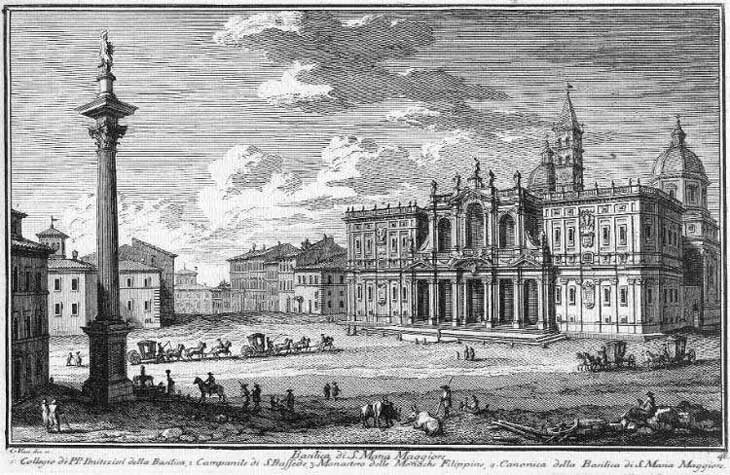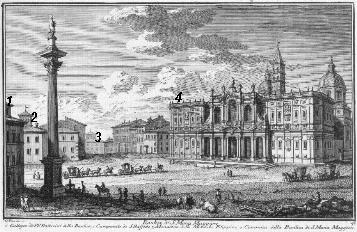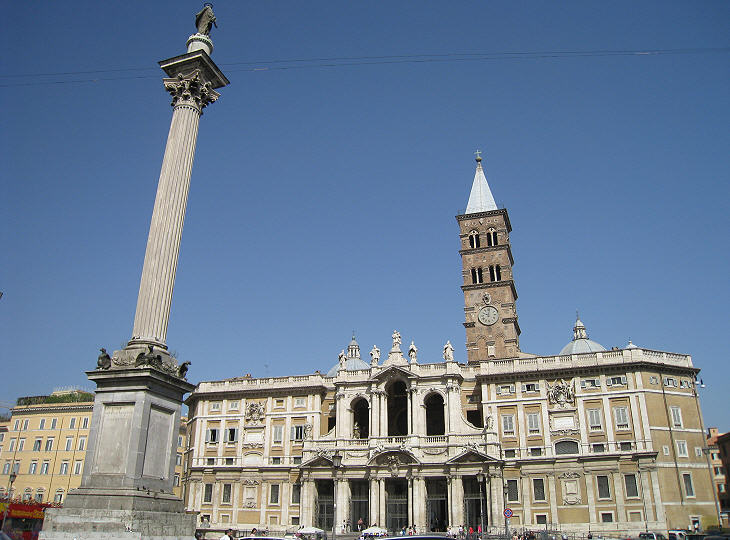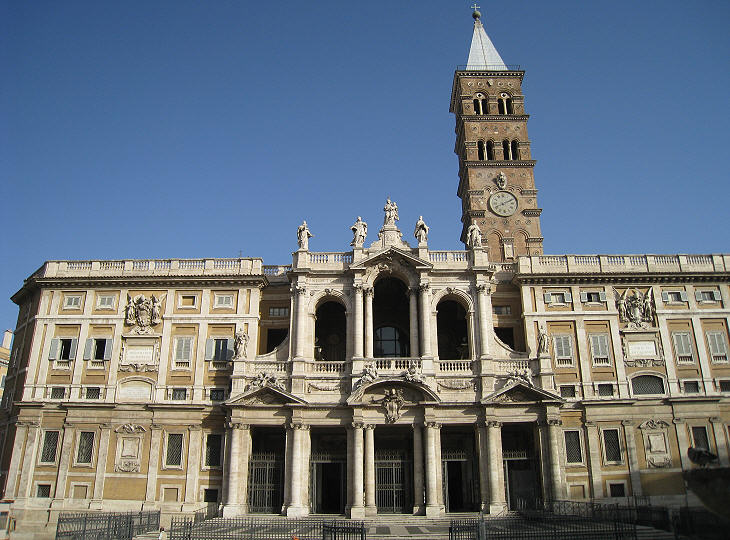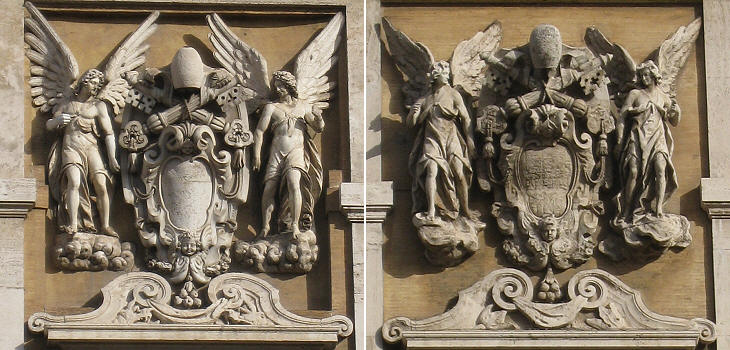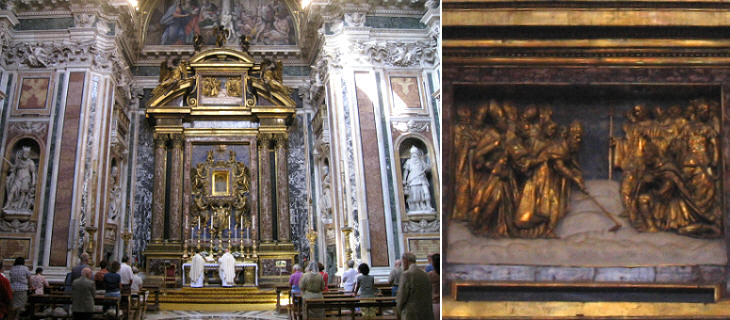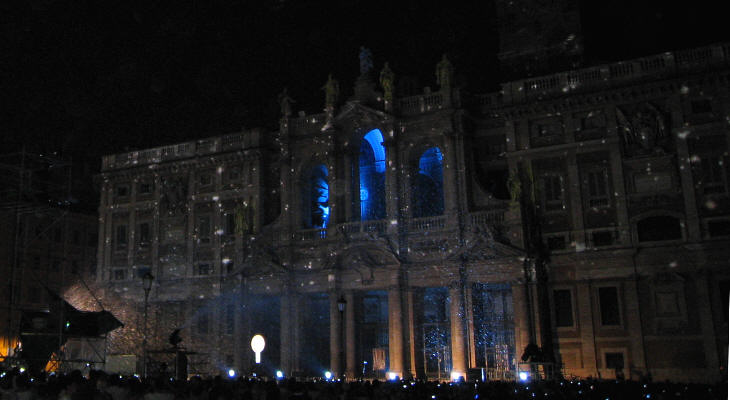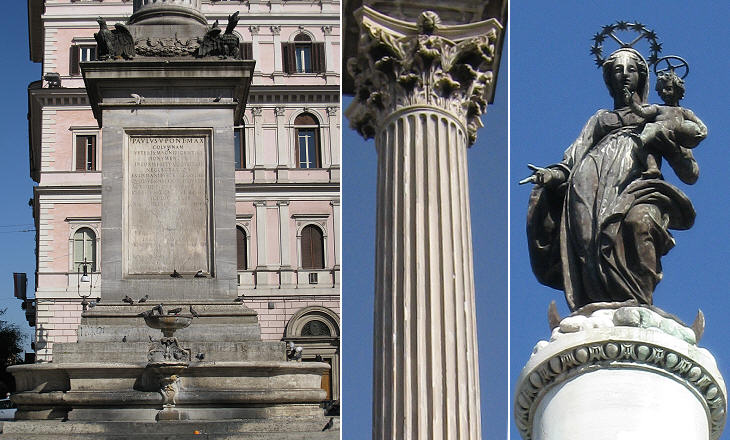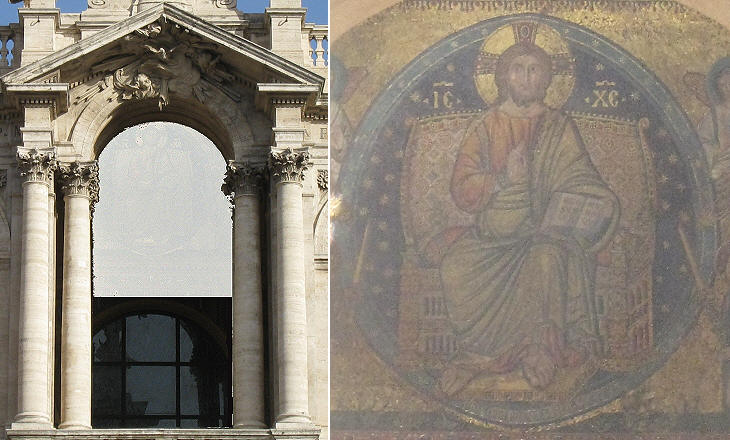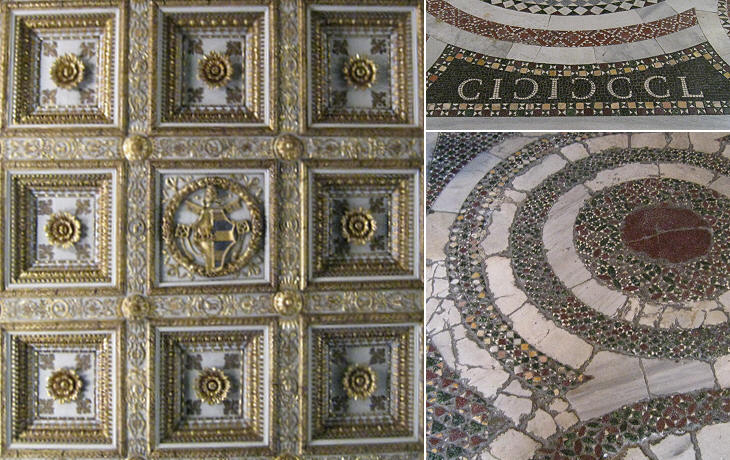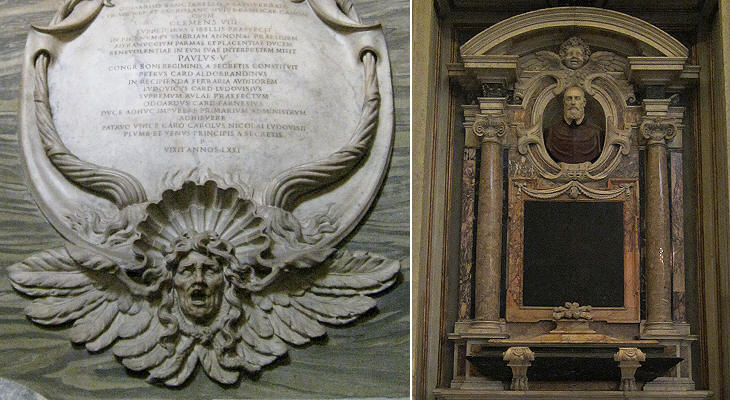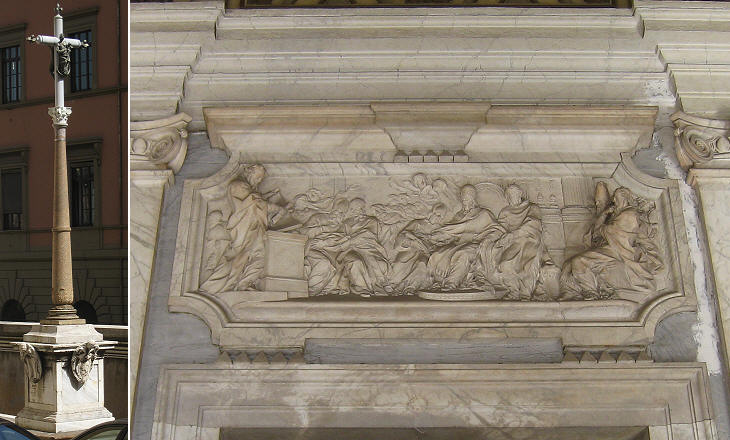

What's New!
Detailed Sitemap
All images © by Roberto Piperno, owner of the domain. Write to romapip@quipo.it. Text edited by Rosamie Moore.
Page revised in August 2009.
|
S. Maria Maggiore (Book
3) (Map A3)
(Day 2) (View B8)
(Rione Monti)
In this page:
The plate by Giuseppe Vasi
Today's view
S. Maria Maggiore
The Column
The Miracle of the Snow
The Loggia
Interior
The Plate (No. 48)
The basilica of S. Maria Maggiore was completed by
Pope Benedict XIV in 1743 with the construction
of a new façade and of a building to its left which matched that already existing to its right. The additions were designed by Ferdinando Fuga.
The view is taken from the green dot in the small 1748 map below.
In the description below the plate Vasi made reference to: 1) A house (pulled down in the XIXth century) belonging to the priests of the Basilica;
2) Bell tower of S. Prassede (now hidden by modern buildings);
3) Monastero delle Monache Filippine;
4) Canonica (rectory) della Basilica; 2) and 3) are covered in other pages. Vasi shows S. Maria Maggiore also in
plate 122 (apse of the basilica) and plate 157 (lateral view).
Today
The view in July 2009
At Vasi's time S. Maria Maggiore was almost at the edge of the populated part of the city; some houses and several religious institutions were located to the left of the basilica; its other side bordered on the gardens of
Pope Sixtus V's Villa di Termini.
The construction of the Central Railway Station on the site of the villa has turned the area into a very busy one and the basilica has become a gigantic roundabout for cars and buses going to and from the Railway Station.
The basilica per se has not been modified.
Read Henry James's account of his visit to this site in 1873.
Read William Dean Howells' account of his visit to this site in 1908.
You may wish to see the basilica in a 1588 Guide to Rome.
S. Maria Maggiore
Façade
Mark Twain visited Italy in 1867 and in "The Innocents Abroad", published in 1869 he wrote about the rank of Holy Personages in Rome:
"First: The Mother of God" - otherwise the Virgin Mary.
Second: The Deity.
Third: Peter.
Fourth:
Some twelve of fifteen canonized popes and martyrs.
Fifth: Jesus Christ the Saviour (but always as an infant in arms)."
This rank was based on the number of churches dedicated to the Holy Personages; in particular he wrote "There are so many churches named for Mary that they have to be distinguished by all sorts of affixes".
In the case of S. Maria Maggiore the affix is a reference to its size. It was the first church dedicated to the Virgin Mary and for a time it was referred to simply as "S. Maria".
(left) The bell tower; (right) detail of its decoration
S. Maria Maggiore was built at the top of Cispius, the highest peak of the Esquiline, which in turn is the highest hill of Rome; in addition the bell tower of the basilica is the tallest of Rome so it is clearly visible from most parts of the city; it was built in 1375-76 probably to celebrate the expected return of the Pope from Avignon. Its design is similar to previous Romanesque bell towers, but its current appearance is heavier than that of others, also because some windows were sealed up.
Pope Julius II added the golden globe and the cross to its apex.
(left) Coat of arms of Pope Paul V with angels by Nicolas Cordier and Ambrogio Buonvicino; (right) coat of arms of Pope Benedict XIV with angels by an unknown artist
Flaminio Ponzio designed for Pope Paul V the two buildings we
see on the sides of the façade, but he actually built only that to its right. The other building was
completed in 1721-43. They both were decorated with a gigantic coat of arms of the pope between two angels; when seen side by side they show the changes in portraying angels during the baroque period; the angels by Cordier and
Buonvicino have a masculine body which is clearly visible beneath a light dress and their wings are arranged in a very harmonic way, whereas those designed for the other coat of arms have covered bodies and their wings are less detailed.
For more about Baroque Angels click here. The actual coats of arms of the popes were erased during the French occupation of Rome.
The Miracle of the Snow
(left) Cappella Paolina; (right) relief depicting the miracle
S. Maria Maggiore is also called Basilica Liberiana and S. Maria ad Nives (snow): both names make reference to the traditional account of its foundation. On the night before August 5, 358, Pope Liberius saw in his dream the Virgin Mary who told him to build a
church on the site where that night snow would have fallen. A precious (bronze, marble and lapis-lazuli) relief by Stefano Maderno in Cappella Paolina portrays the pope drawing the plan of S. Maria Maggiore on the snow which had fallen on the top of the Esquiline hill.
Although miracles do not call for scientific explanations, hail-storms are not unlikely to occur in Rome in August: hailstones may whiten the ground for a short time giving the impression of a snowfall. The event is re-enacted every year.
Re-enactment of the miracle in August 2008
The Column
(left) Base of the column; (centre) shaft and capital; (right) bronze statue by Guillaume Berthélot
Pope Paul V charged Carlo Maderno with the relocation in front of S. Maria Maggiore of a
surviving 46 ft high column of Basilica di Massenzio. At the time this building was known as Tempio della Pace and in the long inscription the pope explained that the column was dedicated to the Virgin Mary because ".. ex cuius visceribus princeps verae pacis genitus est donum dedit" (the Prince who gives true peace came from her womb). For this reason the column is also known as Colonna della Pace.
The column and the small fountain in front of it are decorated with
the eagles and dragons of the pope (the image used as background for this page shows a dragon of the column).
The Loggia
The loggia designed by Ferdinando Fuga
The loggia is the most convincing work by Ferdinando Fuga, but it was criticized by Pope Benedict XIV who found its design was somewhat frivolous
for an ancient basilica; it is interesting to compare it with that of S. Giovanni in Laterano by Alessandro Galilei (they are almost contemporary).
The old façade of S. Maria Maggiore was embellished with mosaics by Filippo Rusuti
towards the end of the XIIIth century; they can still be seen inside the loggia and with
some difficulty also from the square (at least the large mosaic portraying Jesus in perfect Byzantine style). Click here to see some more Roman mosaics.
(left) Central arch of the loggia (photo taken by setting the contrast on its travertine structure); (right) close-up of the mosaic portraying Jesus Christ Pantokrator inside the loggia (photo taken from the same point)
Interior
(left) Ceiling with the coat of arms of Pope Alexander VI; (right-above) 1750 "Cosmatesque" floor; (right-below) an original part of the floor
The ceiling of S. Maria Maggiore was designed by Giuliano da Sangallo towards the end of the XVth
century. According to tradition it was gilded with American gold presented to Pope Alexander VI by
King Ferdinand and Queen Isabella. In 1493 the pope acted as a mediator between Spain and Portugal and he established
a division line between their settlements in South America. The ceiling is decorated with the coats of arms of Alexander VI and of
his uncle Pope Calixtus III.
The floor of the main nave retains parts of its XIIth century mosaic decoration. There are also some
modern parts added in 1750 when the interior was restored for the Holy Year (the Roman numbers celebrating the restoration are rather unusual as M (1,000) and
D (500) are replaced by a combination of C and I). The pieces of stones and marbles used for the mosaics have a different resistance to usage, so an original XIIth century mosaic can easily be detected by walking on it with light shoes.
(left) Detail of Monument to Odoardo Santarelli by Alessandro Algardi; (right) monument to Cardinal Mariano Pierbenedetti (d. 1611)
Six popes and many cardinals and other prelates are buried in S. Maria Maggiore. Most of the monuments were built towards the end of the
XVIth century and the first half of the XVIIth century. In this period S. Pietro was in the
process of being completed and decorated and S. Maria Maggiore became the most important Basilica, especially after
Pope Sixtus V opened Strada Felice (1587 ca.) which allowed easy access to it.
Alessandro Algardi was among the most important sculptors of baroque Rome (see the directory of Baroque Sculpture for other works by him and also by Pietro Bracci who was involved in the decoration of the portico).
(left) Column of Pope Clement VIII; (right) relief by Pietro Bracci in the portico
An unusual column showing a cannon topped by the
cross can be seen in a small courtyard on the northern side of S. Maria Maggiore: it was erected by Pope Clement VIII to celebrate the end of religion wars in France.
It was originally placed in front of S. Antonio Abate, a church very near the basilica: it was relocated here in 1881.
Excerpts from Giuseppe Vasi 1761 Itinerary related to this page:
Basilica di S. Maria Maggiore
La gran colonna, che sta nella piazza di questa basilica, è l'unica, come dicemmo, rimasta intiera di
quelle, che ressero il gran tempio della pace, di cui vedemmo le rovine in Campo Vaccino, da dove
fu quì trasportata da Paolo V. il quale vi pose sopra la statua della ss. Vergine fatta di metallo dorato,
e da piede il fonte di acqua perenne.
Questa Basilica prese un tal nome, perchè fu la maggiore tra tutte le altre chiese dedicate alla ss.
Vergine: Si disse ad Nives, ed ancora Liberiana, perchè da Liberio Papa fu eretta e consagrata ad
istanza e spese di Gio. Patrizio Romano per il miracolo della neve; similmente si disse ad Presepe,
perchè in essa si conserva il Presepio di nostro Signore.
Più volte è stata ristaurata: l'ultima ristaurazione però è stata fatta dal Pont. Bened. XIV. col disegno del
Cav. Fuga, il quale fece il principale prospetto colla loggia della benedizione, e portico. I mosaici però
sono antichi fatti da Filippo Rossetti ajutato da Gaddo Gaddi, e la statua di Filippo IV. Re di Spagna fatta
in metallo stava prima nella sagrestia, come protettore e benefattore di quella Basilica. Entrando in
chiesa si vedono le colonne di marmo greco tutte lustrate, e ridotte in uguale proporzione, mentre
prima erano ruvide e ineguali. A destra evvi il deposito di Niccolò IV. e a sinistra quello di Clem. IX.
Il quadro della prima cappella a destra, che rappresenta la ss. Vergine con Gio. Patrizio è opera di
Giuseppe Bastardo; entro la sagrestia, tra l'altre cose si vede la statua di Paolo V. fatta in metallo,
ed alcuni depositi, fra' quali uno dell'Ambasciatore del Re del Congo scolpito dal Bernino; quivi è il
coro per li tempi di estate, e vi sono pitture del Passignani, e sculture del mentovato Bernini.
Seguitando poi il giro delle cappelle, il quadro della ss. Famiglia è opera di Agostino Masucci, e l'altro,
che siegue, di Stefano Pozzi; la cappella del ss. Crocifisso è adorna di marmi preziosi, e vi si conservano
le reliquie, fra le quali la Culla del nostro Salvatore. Siegue dopo la cappella della ss. Nunziata dipinta da
Pompeo Battoni, e poi quella del santissimo Sagramento, eretta con sagra magnificenza da Sisto V. col
disegno di Domenico Fontana; ed è ornata di marmi, sculture, pitture, e metalli dorati.
I quattro Angioli, che si vedono sull' altare di mezzo reggere il tabernacolo di metallo dorato, e
con una mano tenere 4. torce continuamente accese, sono anch'essi di metallo dorato; e l'altare, che si
vede sotto di questo, dicesi del Presepio, perchè vi stanno le pietre e fieno sopra cui fu posato il nostro
divino Redentore quando nacque; e la statua di s. Gaetano col Canto Bambino in braccio, che si vede
nella nicchia sotto le scale, vi fu posta in memoria dell'apparizione, che esso ebbe in quel medesimo luogo
contemplando la notte di Natale un tal mistero. La cappelletta a destra è dedicata a s. Lucia, ed ha il
quadro dipinto a fresco da Paris, Nogari; quella a sinistra dedicata a s. Girolamo, il di cui corpo sta in
quella basilica, ha il quadro dipinto da Salvator Fontana. La statua di Sisto V. a destra fu scolpita
Valsoldino Lombardo, come anco la coronazione del Papa, e l'istoria della Carità in bassorilievo;
la Giustizia è di Niccolò Fiammingo, e gli altri due bassirilievi sono di Egidio Fiammingo; il s. Francesco è
di Flaminio Vacca, ed il s. Antonio di Padova dell' Olivieri. La statua di s. Pio V. è opera di Lorenzo da
Sarzana, come anco l'istoria a man destra, e l'altra a sinistra è del Cordieri; la coronazione del Papa in
bassorilievo è di Stella Milanese, e li due laterali di Egidio Fiammingo. Nell'urna di metallo dorato, che sta
sotto la statua del Santo, vi è il corpo del medesimo. La statua di s. Pietro martire è del Valsoldino, e
quella di s. Domenico di Gio. Batista della Porta. Le pitture, che sono sopra il cornicione, nella cupola,
ed in altri luoghi, sono opere ben condotte da Paris Nogari, da Gio. Batista Pozzo, da Andrea d'Ancona,
da Giacomo Bresciano, da Salvatore Fontana, e da altri. Questa cappella ha la sagrestia propria, ornata
similmente di pitture e stucchi dorati.
Dipoi siegue il ciborio, o altare Papale, e sta dirimpetto alla tribuna modernamente rifatto da Bened.
XIV. ed ornato con 4. preziose colonne di porfido, che prima sostenevano l'antico portico, e con varj
lavori di metallo dorato; la mensa dell'altare consiste in una grande, e preziosa urna di porfido lavorata
mirabilmente da tutte le quattro parti, ed è stata ornata similmente di metalli dorati. Sotto quest' altare si
vede un finestrino, che corrisponde nel sotterraneo, ove sono molte insigni reliquie, che stavano
nell'antico sotterraneo. Il quadro della Natività del Signore, che sta sull'altare della tribuna, è opera
del Mancini, e li mosaici, che sono in alto, di Giacomo Turrigia ordinati da Niccolò IV. l'an. 1286.
l'arcone però fu fatto da Sisto III. l'an. 438. con tutti li mosaici, che vi sono, siccome ancora li altri,
che girano intorno alla nave maggiore, i quali furono poi riattati dal Card. Pinelli Genovese, che fece
ancora tra le finestre le pitture con ornamenti di stucchi dorati. Il gran soffitto fu dorato da Aless. VI.
col primo oro venuto dall'India, donato a quella Basilica dal Re Cattolico.
Dopo l'altra porta laterale, e dirimpetto alla cappella del ss. Sagramento, evvi quella della
ss. Vergine,
eretta da Paolo V. con somma splendidezza. L'altare principale è ornato di maravigliosi diaspri duri,
lapislazzoli, agate, ed altre pietre preziose: le basi delle colonne, i capitelli, il cornicione, il frontespizio, e
i putti con altri ornamenti sono tutti di metallo dorato ed anco il gran bassorilievo, in cui viene
figurato il miracolo della neve; e gli angioli, che con altri ornati reggono la ss. Immagine, furono
cavati da' modelli di Cammillo Mariani, e gettati da Domenico Ferretti; le pitture sulle lunette, ed
arconi doveva farli Guido Reni; ma per gl' impegni, e raccomandazioni le fece il Cav. d'Arpino, e
quelle della cupola Lodovico Cigoli. La statua di Paolo V. posta nel suo deposito è del Silla, il
bassorilievo a destra di Stefano Maderno, e quello a sinistra del Malvicino; la coronazione è
d'Ippolito Buzio, il bassorilievo a destra è del Valsoldo, e l'altro a sinistra, di Francesco Stati, e li
termini, del detto Buzio; la statua di s. Basilio, quella di Davide sono di Niccolò Cordieri, e le pitture
ne' lati della finestra sopra il cornicione con quelle sull'arcone sono di Guido Reni. La statua di
Clemente VIII. nel deposito incontro è del Silla, il bassorilievo a destra è del Malvicino e quello a
sinistra del Mariani, finiti poi dal Mochi; la coronazione è di Pietro Bernini, e li termini a destra, del
detto Bozio, e quelli a sinistra, del Valsoldo. Le pitture ai lati della finestra, e quelle sull'arcone sono di
Guido Reni, fuorchè la Madonna, che fu fatta dal Lanfranco. La cappelletta di s. Carlo Borromeo fu
dipinta da Baldassare della Croce, e quella di s. Francesca Romana dal Baglioni. Questa magnifica
cappella ha similmente la sagrestia propria ornata di stucchi dorati, e pitture del Cav. Passignani.
Siegue dopo la cappella Sforza eretta con architettura del Buonarroti; e si vede il quadro dell'altare
dipinto da Girolamo da Sermoneta, e le pitture a fresco del Nebbia. Ora in questa cappella è stato formato
il coro per il tempo d'inverno. Le pitture a fresco nella cappella, che siegue sono di Baldassare della
Croce, e d'altri. Appresso evvi la cappella de' Sig. Cesi, il di cui quadro è del riferito Sermoneta; quello
però con s Pietro, e s. Paolo è del Novara, l'altro con s. Caterina, di Luigi Gentile, e quell' incontro, di
Carlo Cesi; ma la Santa, che disputa con li dottori, si crede del Canini. I depositi di marmo con urne di
paragone, e statue di metallo sono opere di fra Guglielmo della Porta, e quei di Monsig. Santarelli, e di
Costanzo Patrizi, che stanno in chiesa, sono dell'Algardi.
E' questa una delle sette chiese, ed ancora delle quattro Basiliche, che si visitano nell'anno del
Giubbileo, e però vi è nel portico la Porta santa, come nelle altre tre Basiliche di s. Pietro, di s. Paolo,
e del Laterano.
|
Next plate in Book 3:
S. Eusebio
Next step in Day 2 itinerary:
Chiesa di S. Prassede
Next step in your tour of Rione Monti: Monastero della SS. Annunziata
|


